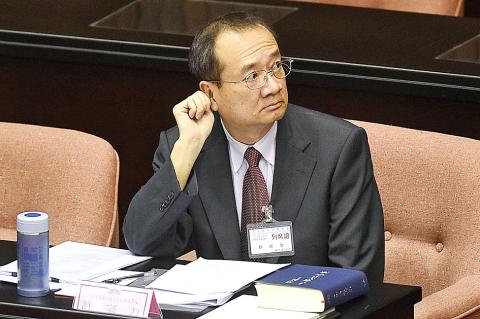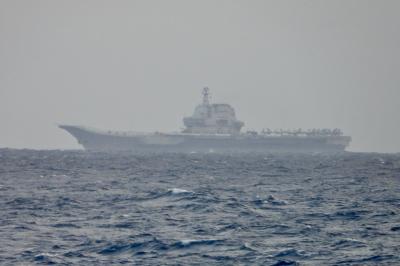Cross-strait relations are “special state-to-state relations” akin to the relations between West and East Germany, former grand justice Hsu Tzong-li (許宗力) yesterday told lawmakers during a review of his nomination to be head of the Judicial Yuan.
Hsu’s comment was in response to Chinese Nationalist Party (KMT) Legislator Alicia Wang’s (王育敏) question on whether his opinions on cross-strait relations were similar to those of former president Lee Teng-hui (李登輝), citing Hsu’s 1996 article, “How Laws Influenced the Changes in Cross-Strait Relations and the Latest Developments” (兩岸關係法律定為百年來的演變與最新發展) in the The Taiwan Law Review (月旦法學雜誌).
Lee’s “special state-to-state” model of cross-strait relations, announced on July 8, 1999, was aimed at countering China’s description of Taiwan as a “renegade province.”

Photo: Chen Chih-chu, Taipei Times
“Taiwan is a distinct sovereign independent nation separate from the People’s Republic of China [PRC] in Mainland China; its name is the Republic of China [ROC],” Hsu wrote in his article, adding: “The ROC is factually and legally independent from all other nations in the world, including the PRC.”
Hsu said he has always claimed “special state-to-state relations” and never used the phrase “two-state theory.”
When asked how his opinion differed from former president Ma Ying-jeou’s (馬英九) “one China, with different interpretations” framework, Hsu said that Ma’s cross-strait model claimed sovereignty over China and outer Mongolia, or the Republic of Mongolia, but that his model did not.
Ma’s preferred model is also known as the so-called “1992 consensus,” a phrase that former Mainland Affairs Council chairman Su Chi (蘇起) admitted to making up in 2000, which refers to a tacit understanding between the KMT and Beijing that both sides acknowledge there is “one China,” with each side having its own interpretation of what “China” means.
“Member of the Legislative Yuan, as well as the president, are elected by the 23 million people in Taiwan since 1991. We do not represent China. Therefore I think our sovereignty does not include mainland China,” Hsu said.
As for the distinction between the “Taiwan Area” and “Mainland Area” as stipulated in the Constitution, Hsu said that this was a political statement written into the Constitution and is not legally binding at the local government level, adding that were it legally binding, it would mean that Taiwanese would have to elect an “area administrator.”
New Power Party (NPP) Executive Director Huang Kuo-chang (黃國昌) asked Hsu about President Tsai Ing-wen’s (蔡英文) executive initiatives.
Huang asked if Tsai’s High-Level Policy Coordination Meeting initiative — a body composed of the premier, Democratic Progressive Party (DPP) secretary-general, key members of the DPP caucus and think tanks — crosses a “red line” regarding constitutional limits on presidential powers.
“I believe it must operate under the constitutional framework and I agree that regulations will cause many difficulties for Tsai. I hope the legislature considers constitutional amendments,” Hsu said.
Huang expressed the concern that the High-Level Policy Coordination Meeting sessions might lead to “controversial constitutional disputes” and asked Hsu if he thought the sessions should proceed as planned.
“I believe it warrants further consideration,” Hsu said.
Presidential Office spokesman Alex Huang (黃重諺) later issued a statement saying that “Hsu was responding to the issue of how the president’s constitutional role and powers should correspond with political responsibility and the spirit of democratic politics, and he believes that certain constitutional requirements require further review and consideration.”
The spokesman dismissed claims that the High-Level Policy Coordination Meeting was an unconstitutional expansion of presidential powers, saying that the sessions would enhance the Cabinet’s policymaking and “should cause no concern with regard to the constitutional boundaries of the president.”

US President Donald Trump yesterday announced sweeping "reciprocal tariffs" on US trading partners, including a 32 percent tax on goods from Taiwan that is set to take effect on Wednesday. At a Rose Garden event, Trump declared a 10 percent baseline tax on imports from all countries, with the White House saying it would take effect on Saturday. Countries with larger trade surpluses with the US would face higher duties beginning on Wednesday, including Taiwan (32 percent), China (34 percent), Japan (24 percent), South Korea (25 percent), Vietnam (46 percent) and Thailand (36 percent). Canada and Mexico, the two largest US trading

AIR SUPPORT: The Ministry of National Defense thanked the US for the delivery, adding that it was an indicator of the White House’s commitment to the Taiwan Relations Act Deputy Minister of National Defense Po Horng-huei (柏鴻輝) and Representative to the US Alexander Yui on Friday attended a delivery ceremony for the first of Taiwan’s long-awaited 66 F-16C/D Block 70 jets at a Lockheed Martin Corp factory in Greenville, South Carolina. “We are so proud to be the global home of the F-16 and to support Taiwan’s air defense capabilities,” US Representative William Timmons wrote on X, alongside a photograph of Taiwanese and US officials at the event. The F-16C/D Block 70 jets Taiwan ordered have the same capabilities as aircraft that had been upgraded to F-16Vs. The batch of Lockheed Martin

China's military today said it began joint army, navy and rocket force exercises around Taiwan to "serve as a stern warning and powerful deterrent against Taiwanese independence," calling President William Lai (賴清德) a "parasite." The exercises come after Lai called Beijing a "foreign hostile force" last month. More than 10 Chinese military ships approached close to Taiwan's 24 nautical mile (44.4km) contiguous zone this morning and Taiwan sent its own warships to respond, two senior Taiwanese officials said. Taiwan has not yet detected any live fire by the Chinese military so far, one of the officials said. The drills took place after US Secretary

THUGGISH BEHAVIOR: Encouraging people to report independence supporters is another intimidation tactic that threatens cross-strait peace, the state department said China setting up an online system for reporting “Taiwanese independence” advocates is an “irresponsible and reprehensible” act, a US government spokesperson said on Friday. “China’s call for private individuals to report on alleged ‘persecution or suppression’ by supposed ‘Taiwan independence henchmen and accomplices’ is irresponsible and reprehensible,” an unnamed US Department of State spokesperson told the Central News Agency in an e-mail. The move is part of Beijing’s “intimidation campaign” against Taiwan and its supporters, and is “threatening free speech around the world, destabilizing the Indo-Pacific region, and deliberately eroding the cross-strait status quo,” the spokesperson said. The Chinese Communist Party’s “threats